
MapCode :
7 658 037*28
Phone :
077-522-3830
Hours :
Open daily 24/7
Address :
7 Miideracho, Otsu, Shiga 520-0034
13.1
km / 8.2
miles
-
(28
minutes)
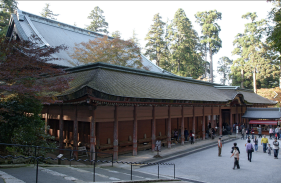
MapCode :
7 866 120*52
Phone :
077-578-0001
Website :
Description :
even marched on the capital to enforce monastic demands.
As part of a program to remove all potential rivals and unite the country, warlord Oda Nobunaga ended this Buddhist militancy in 1571 by attacking Enryaku-ji, leveling the buildings and slaughtering monks.
Enryaku-ji's current structures date from the late 16th century through the first half of the 17th century, when the temple was reconstructed following a change of government. Only one minor building survived, the Ruri-dō ("Lapis Lazuli Hall"), which is located down a long, unmarked path from the Sai-tō complex. The structure dates to the 13th century and was repaired twice during the 20th century following harsh weather. During reconstruction, some buildings were transferred from other temples, notably Mii-dera, and thus the buildings themselves are old, though they have not always been at this location.
Today, most of Enryaku-ji's buildings are clustered in three areas: Tō-dō (東塔, "East Pagoda"), Sai-tō (西塔, "West Pagoda"), and Yokokawa (横川). The monastery's most important buildings are concentrated in Tō-dō. Sai-tō is a 20-minute walk away, primarily downhill from Tō-dō, and also features several important buildings. Yokokawa is more isolated and less visited, about a 1:30 walk, and is most easily reached by bus, which connects the three complexes and other locations on the mountain.
To-do includes the Konpon Chu-do (a national treasure), the Kaidan-in (important cultural asset), the Hokke So Ji-in, Amida-do (training hall), the Dai Ko-do (important cultural asset), and the Kokuho-den (national treasure storage building).
Courtesy of Wikipedia
As part of a program to remove all potential rivals and unite the country, warlord Oda Nobunaga ended this Buddhist militancy in 1571 by attacking Enryaku-ji, leveling the buildings and slaughtering monks.
Enryaku-ji's current structures date from the late 16th century through the first half of the 17th century, when the temple was reconstructed following a change of government. Only one minor building survived, the Ruri-dō ("Lapis Lazuli Hall"), which is located down a long, unmarked path from the Sai-tō complex. The structure dates to the 13th century and was repaired twice during the 20th century following harsh weather. During reconstruction, some buildings were transferred from other temples, notably Mii-dera, and thus the buildings themselves are old, though they have not always been at this location.
Today, most of Enryaku-ji's buildings are clustered in three areas: Tō-dō (東塔, "East Pagoda"), Sai-tō (西塔, "West Pagoda"), and Yokokawa (横川). The monastery's most important buildings are concentrated in Tō-dō. Sai-tō is a 20-minute walk away, primarily downhill from Tō-dō, and also features several important buildings. Yokokawa is more isolated and less visited, about a 1:30 walk, and is most easily reached by bus, which connects the three complexes and other locations on the mountain.
To-do includes the Konpon Chu-do (a national treasure), the Kaidan-in (important cultural asset), the Hokke So Ji-in, Amida-do (training hall), the Dai Ko-do (important cultural asset), and the Kokuho-den (national treasure storage building).
Courtesy of Wikipedia
Hours :
Open daily 08:30 - 16:30
Address :
4220 Sakamotohonmachi, Otsu, Shiga 520-0116
0.9
km / 0.6
miles
-
(2
minutes)
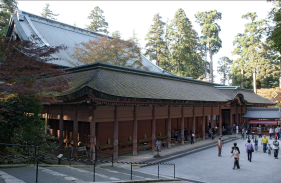
MapCode :
7 865 189*21
Phone :
077-578-0001
Website :
Description :
Enryaku-ji is a Tendai monastery located on Mount Hiei in Ōtsu, in Shiga Prefecture, overlooking Kyoto. It was first founded in 788 during the early Heian period (794–1185) by Saichō (767–822), also known as Dengyō Daishi, who introduced the Tendai sect of Mahayana Buddhism to Japan from China. The temple complex has undergone several reconstruction efforts since then, with the most significant (that of the main hall) taking place in 1642 under Tokugawa Iemitsu.
Enryaku-ji is the headquarters of the Tendai sect and one of the most significant monasteries in Japanese history. As such, it is part of the UNESCO World Heritage Site "Historic Monuments of Ancient Kyoto (Kyoto, Uji and Otsu Cities)". The founders of Jōdo-shū, Jōdo Shinshū, Sōtō Zen, and Nichiren Buddhism all spent time at the monastery. Enryaku-ji is also the center for the practice of kaihōgyō (aka the "marathon monks").
With the support of Emperor Kanmu, the Buddhist monk Saichō ordained a hundred disciples in 807. Maintaining a strict discipline on Mt. Hiei, his monks lived in seclusion for twelve years of study and meditation. After this period, the best students were retained in positions in the monastery and others graduated into positions in the government. At the peak of its power, Enryaku-ji was a huge complex of as many as 3,000 sub-temples and a powerful army of warrior monks (sōhei).
In the tenth century, succession disputes broke out between Tendai monks of the line of Ennin and Enchin. These disputes resulted in opposing Tendai centers at Enryaku-ji and at Mii-dera, known respectively as the Mountain Order (sanmon) and the Temple Order ( jimon). Warrior monks were used to settle the disputes, and Tendai leaders began to hire mercenary armies who threatened rivals and even marched on the capital to enforce monastic demands.
As part of a program to remove all potential rivals and unite the country, warlord Oda Nobunaga ended this Buddhist militancy in 1571 by attacking Enryaku-ji, leveling the buildings and slaughtering monks.
Enryaku-ji's current structures date from the late 16th century through the first half of the 17th century, when the temple was reconstructed following a change of government. Only one minor building survived, the Ruri-dō ("Lapis Lazuli Hall"), which is located down a long, unmarked path from the Sai-tō complex. The structure dates to the 13th century and was repaired twice during the 20th century following harsh weather. During reconstruction, some buildings were transferred from other temples, notably Mii-dera, and thus the buildings themselves are old, though they have not always been at this location.
Today, most of Enryaku-ji's buildings are clustered in three areas: Tō-dō (東塔, "East Pagoda"), Sai-tō (西塔, "West Pagoda"), and Yokokawa (横川). The monastery's most important buildings are concentrated in Tō-dō. Sai-tō is a 20-minute walk away, primarily downhill from Tō-dō, and also features several important buildings. Yokokawa is more isolated and less visited, about a 1:30 walk, and is most easily reached by bus, which connects the three complexes and other locations on the mountain.
Sai-to includes Shaka-do (important cultural asset), Ninai-do (important cultural asset), Ruri-do (important cultural asset), Jodo-in (mausoleum of Dengyo Daishi), and Tsubaki-do.
Courtesy of Wikipedia
Enryaku-ji is the headquarters of the Tendai sect and one of the most significant monasteries in Japanese history. As such, it is part of the UNESCO World Heritage Site "Historic Monuments of Ancient Kyoto (Kyoto, Uji and Otsu Cities)". The founders of Jōdo-shū, Jōdo Shinshū, Sōtō Zen, and Nichiren Buddhism all spent time at the monastery. Enryaku-ji is also the center for the practice of kaihōgyō (aka the "marathon monks").
With the support of Emperor Kanmu, the Buddhist monk Saichō ordained a hundred disciples in 807. Maintaining a strict discipline on Mt. Hiei, his monks lived in seclusion for twelve years of study and meditation. After this period, the best students were retained in positions in the monastery and others graduated into positions in the government. At the peak of its power, Enryaku-ji was a huge complex of as many as 3,000 sub-temples and a powerful army of warrior monks (sōhei).
In the tenth century, succession disputes broke out between Tendai monks of the line of Ennin and Enchin. These disputes resulted in opposing Tendai centers at Enryaku-ji and at Mii-dera, known respectively as the Mountain Order (sanmon) and the Temple Order ( jimon). Warrior monks were used to settle the disputes, and Tendai leaders began to hire mercenary armies who threatened rivals and even marched on the capital to enforce monastic demands.
As part of a program to remove all potential rivals and unite the country, warlord Oda Nobunaga ended this Buddhist militancy in 1571 by attacking Enryaku-ji, leveling the buildings and slaughtering monks.
Enryaku-ji's current structures date from the late 16th century through the first half of the 17th century, when the temple was reconstructed following a change of government. Only one minor building survived, the Ruri-dō ("Lapis Lazuli Hall"), which is located down a long, unmarked path from the Sai-tō complex. The structure dates to the 13th century and was repaired twice during the 20th century following harsh weather. During reconstruction, some buildings were transferred from other temples, notably Mii-dera, and thus the buildings themselves are old, though they have not always been at this location.
Today, most of Enryaku-ji's buildings are clustered in three areas: Tō-dō (東塔, "East Pagoda"), Sai-tō (西塔, "West Pagoda"), and Yokokawa (横川). The monastery's most important buildings are concentrated in Tō-dō. Sai-tō is a 20-minute walk away, primarily downhill from Tō-dō, and also features several important buildings. Yokokawa is more isolated and less visited, about a 1:30 walk, and is most easily reached by bus, which connects the three complexes and other locations on the mountain.
Sai-to includes Shaka-do (important cultural asset), Ninai-do (important cultural asset), Ruri-do (important cultural asset), Jodo-in (mausoleum of Dengyo Daishi), and Tsubaki-do.
Courtesy of Wikipedia
Hours :
Open daily 09:00 - 16:00
Address :
4220 Sakamotohon-machi, Otsu, Shiga 520-0116
4.3
km / 2.7
miles
-
(7
minutes)
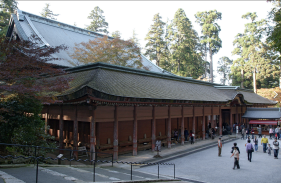
MapCode :
479 056 087*54
Phone :
077-578-0001
Website :
Description :
Enryaku-ji is a Tendai monastery located on Mount Hiei in Ōtsu, in Shiga Prefecture, overlooking Kyoto. It was first founded in 788 during the early Heian period (794–1185) by Saichō (767–822), also known as Dengyō Daishi, who introduced the Tendai sect of Mahayana Buddhism to Japan from China. The temple complex has undergone several reconstruction efforts since then, with the most significant (that of the main hall) taking place in 1642 under Tokugawa Iemitsu.
Enryaku-ji is the headquarters of the Tendai sect and one of the most significant monasteries in Japanese history. As such, it is part of the UNESCO World Heritage Site "Historic Monuments of Ancient Kyoto (Kyoto, Uji and Otsu Cities)". The founders of Jōdo-shū, Jōdo Shinshū, Sōtō Zen, and Nichiren Buddhism all spent time at the monastery. Enryaku-ji is also the center for the practice of kaihōgyō (aka the "marathon monks").
With the support of Emperor Kanmu, the Buddhist monk Saichō ordained a hundred disciples in 807. Maintaining a strict discipline on Mt. Hiei, his monks lived in seclusion for twelve years of study and meditation. After this period, the best students were retained in positions in the monastery and others graduated into positions in the government. At the peak of its power, Enryaku-ji was a huge complex of as many as 3,000 sub-temples and a powerful army of warrior monks (sōhei).
In the tenth century, succession disputes broke out between Tendai monks of the line of Ennin and Enchin. These disputes resulted in opposing Tendai centers at Enryaku-ji and at Mii-dera, known respectively as the Mountain Order (sanmon) and the Temple Order ( jimon). Warrior monks were used to settle the disputes, and Tendai leaders began to hire mercenary armies who threatened rivals and even marched on the capital to enforce monastic demands.
As part of a program to remove all potential rivals and unite the country, warlord Oda Nobunaga ended this Buddhist militancy in 1571 by attacking Enryaku-ji, leveling the buildings and slaughtering monks.
Enryaku-ji's current structures date from the late 16th century through the first half of the 17th century, when the temple was reconstructed following a change of government. Only one minor building survived, the Ruri-dō ("Lapis Lazuli Hall"), which is located down a long, unmarked path from the Sai-tō complex. The structure dates to the 13th century and was repaired twice during the 20th century following harsh weather. During reconstruction, some buildings were transferred from other temples, notably Mii-dera, and thus the buildings themselves are old, though they have not always been at this location.
Today, most of Enryaku-ji's buildings are clustered in three areas: Tō-dō (東塔, "East Pagoda"), Sai-tō (西塔, "West Pagoda"), and Yokokawa (横川). The monastery's most important buildings are concentrated in Tō-dō. Sai-tō is a 20-minute walk away, primarily downhill from Tō-dō, and also features several important buildings. Yokokawa is more isolated and less visited, about a 1:30 walk, and is most easily reached by bus, which connects the three complexes and other locations on the mountain.
Yokawa includes the Yokawa Chu-do, the Eshin-do, the Konpon Nyoho-to, the Joko-in, and the Shiki Ko-do (Gansan Daishi-do).
Courtesy of Wikipedia
Enryaku-ji is the headquarters of the Tendai sect and one of the most significant monasteries in Japanese history. As such, it is part of the UNESCO World Heritage Site "Historic Monuments of Ancient Kyoto (Kyoto, Uji and Otsu Cities)". The founders of Jōdo-shū, Jōdo Shinshū, Sōtō Zen, and Nichiren Buddhism all spent time at the monastery. Enryaku-ji is also the center for the practice of kaihōgyō (aka the "marathon monks").
With the support of Emperor Kanmu, the Buddhist monk Saichō ordained a hundred disciples in 807. Maintaining a strict discipline on Mt. Hiei, his monks lived in seclusion for twelve years of study and meditation. After this period, the best students were retained in positions in the monastery and others graduated into positions in the government. At the peak of its power, Enryaku-ji was a huge complex of as many as 3,000 sub-temples and a powerful army of warrior monks (sōhei).
In the tenth century, succession disputes broke out between Tendai monks of the line of Ennin and Enchin. These disputes resulted in opposing Tendai centers at Enryaku-ji and at Mii-dera, known respectively as the Mountain Order (sanmon) and the Temple Order ( jimon). Warrior monks were used to settle the disputes, and Tendai leaders began to hire mercenary armies who threatened rivals and even marched on the capital to enforce monastic demands.
As part of a program to remove all potential rivals and unite the country, warlord Oda Nobunaga ended this Buddhist militancy in 1571 by attacking Enryaku-ji, leveling the buildings and slaughtering monks.
Enryaku-ji's current structures date from the late 16th century through the first half of the 17th century, when the temple was reconstructed following a change of government. Only one minor building survived, the Ruri-dō ("Lapis Lazuli Hall"), which is located down a long, unmarked path from the Sai-tō complex. The structure dates to the 13th century and was repaired twice during the 20th century following harsh weather. During reconstruction, some buildings were transferred from other temples, notably Mii-dera, and thus the buildings themselves are old, though they have not always been at this location.
Today, most of Enryaku-ji's buildings are clustered in three areas: Tō-dō (東塔, "East Pagoda"), Sai-tō (西塔, "West Pagoda"), and Yokokawa (横川). The monastery's most important buildings are concentrated in Tō-dō. Sai-tō is a 20-minute walk away, primarily downhill from Tō-dō, and also features several important buildings. Yokokawa is more isolated and less visited, about a 1:30 walk, and is most easily reached by bus, which connects the three complexes and other locations on the mountain.
Yokawa includes the Yokawa Chu-do, the Eshin-do, the Konpon Nyoho-to, the Joko-in, and the Shiki Ko-do (Gansan Daishi-do).
Courtesy of Wikipedia
Hours :
Open daily 09:00 - 16:00
Address :
Sakamotohonmachi, Otsu, Shiga 520-0116
1.7
km / 1.0
miles
-
(3
minutes)

MapCode :
479 058 814*72
Phone :
077-578-2139
Website :
Hours :
Open daily 09:00M – 19:00
Address :
Sakamotohonmachi, Otsu, Shiga 520-0116, Japan
10.3
km / 6.4
miles
-
(21
minutes)
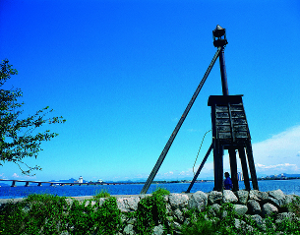
MapCode :
616 096 650*17
Phone :
077-573-1000
Description :
This 8 meter wooden lighthouse was the first in the prefecture, built in 1875.
The area near the lighthouse is the narrowest portion of Lake Biwa, and in years past had been the site of many nautical collisions, so the lighthouse was built to create safer conditions on the lake. The lighthouse was lit for what would have been the last time in 1951, but in 1973, locals began moving to restore the lighthouse, and put it back in commission.
Courtesy of Otsu Tourism Association
The area near the lighthouse is the narrowest portion of Lake Biwa, and in years past had been the site of many nautical collisions, so the lighthouse was built to create safer conditions on the lake. The lighthouse was lit for what would have been the last time in 1951, but in 1973, locals began moving to restore the lighthouse, and put it back in commission.
Courtesy of Otsu Tourism Association
Hours :
Monday: Open 24 hours
Tuesday: Open 24 hours
Wednesday: Open 24 hours
Thursday: Open 24 hours
Friday: Open 24 hours
Saturday: Open 24 hours
Sunday: Open 24 hours
Tuesday: Open 24 hours
Wednesday: Open 24 hours
Thursday: Open 24 hours
Friday: Open 24 hours
Saturday: Open 24 hours
Sunday: Open 24 hours
Address :
1 Chome-22 Imakatata, Otsu, Shiga 520-0241
7.0
km / 4.3
miles
-
(14
minutes)
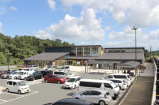

MapCode :
616 243 706*82
Phone :
077-594-8131
Website :
Hours :
Open daily 09:00 – 18:00
Address :
528 Waninaka, Otsu, Shiga 520-0526
21.3
km / 13.2
miles
-
(27
minutes)

MapCode :
263 376 411*47
Phone :
074-036-1555
Description :
Shirahige-jinja Shrine was founded 1900 years ago, boasting the longest history for a shrine Omi. This is also one of the constituent elements of the Japan Heritage story. Against the backdrop of the lake island of Okishima, the sight of fishing boats going about their business between the torii gates in the offing is particularly stunning. Furthermore, the gates are illuminated at night. (Illumination times: Saturday and Sunday - around 2 hours after sunset, September 5 - from sunset until around 10pm, New Year's Eve - until dawn, January 1 to January 5 - from sunset until around 9pm)
Early morning is a particularly recommended time to visit, with the morning sun rising inside the Torii gate, and this has recently also become is a popular time to take photos.
Courtesty of Biwako Visitors Bureau
Early morning is a particularly recommended time to visit, with the morning sun rising inside the Torii gate, and this has recently also become is a popular time to take photos.
Courtesty of Biwako Visitors Bureau
Hours :
Monday: Open 24 hours
Tuesday: Open 24 hours
Wednesday: Open 24 hours
Thursday: Open 24 hours
Friday: Open 24 hours
Saturday: Open 24 hours
Sunday: Open 24 hours
Tuesday: Open 24 hours
Wednesday: Open 24 hours
Thursday: Open 24 hours
Friday: Open 24 hours
Saturday: Open 24 hours
Sunday: Open 24 hours
Address :
Ukawa, Takashima, Shiga 520-1122
28.3
km / 17.6
miles
-
(31
minutes)

MapCode :
192 184 862*71
Phone :
074-027-1121
Description :
About 500 metasequoias are planted in roadside which leads to Makino high plain from Makino pick Rand over 924 kilometers.
The one Makino-cho fruiter Productive Cooperation planted as a part of schoolchild farm "Sato learned in Makino earth" maintenance business in 1981 (1981) was starting, but because extension was brought by the people in an area such as a union relations person up, and more prefectural highways also cooperated after that, and was planted, and was increased, this row of trees was this present grand form.
The view with the complete symmetry-shaped budding in spring, deep green of fresh green and summer, the autumnal tints of the autumn, a winter nude tree, a snowflake and the road which develops straight with Namiki of a beautiful conical metasequoia in each season produce also harmonizes with the mountains in Nosaka mountain region which becomes the distant view, and the people who visit are charmed.
It was said that it was similar to the avenue of "winter sonata" which was selected in Shin "and" Japanese roadside tree 100 kei of (in 1994) November, 1994 and the Yomiuri Shimbun and became a firebrand of Han way boom in 2004 (2004), and many cameramen and a family came to visit. It's selected by "sweetheart's sacred place" in 2008 (2008) and is also a popular spot in the young generation.
※ The person who can come for a car use Makino pick Rand parking lot (no charge), please.
★ A metasequoia...
By the fallen leaves tall tree by which metasequoias are Chinese origin and the pass family metasequoia genus, the Japanese name is a metaseqouia. Because its form is similar to the sequoia the biggest tree height in which I equal 35m is called when I also come to 115m, the tree height is called a META (I transformed.) sequoia.
The one Makino-cho fruiter Productive Cooperation planted as a part of schoolchild farm "Sato learned in Makino earth" maintenance business in 1981 (1981) was starting, but because extension was brought by the people in an area such as a union relations person up, and more prefectural highways also cooperated after that, and was planted, and was increased, this row of trees was this present grand form.
The view with the complete symmetry-shaped budding in spring, deep green of fresh green and summer, the autumnal tints of the autumn, a winter nude tree, a snowflake and the road which develops straight with Namiki of a beautiful conical metasequoia in each season produce also harmonizes with the mountains in Nosaka mountain region which becomes the distant view, and the people who visit are charmed.
It was said that it was similar to the avenue of "winter sonata" which was selected in Shin "and" Japanese roadside tree 100 kei of (in 1994) November, 1994 and the Yomiuri Shimbun and became a firebrand of Han way boom in 2004 (2004), and many cameramen and a family came to visit. It's selected by "sweetheart's sacred place" in 2008 (2008) and is also a popular spot in the young generation.
※ The person who can come for a car use Makino pick Rand parking lot (no charge), please.
★ A metasequoia...
By the fallen leaves tall tree by which metasequoias are Chinese origin and the pass family metasequoia genus, the Japanese name is a metaseqouia. Because its form is similar to the sequoia the biggest tree height in which I equal 35m is called when I also come to 115m, the tree height is called a META (I transformed.) sequoia.
Hours :
Open daily 24/7
Address :
Makinocho Makino, Takashima, Shiga 520-1835
34.7
km / 21.5
miles
-
(46
minutes)

MapCode :
460 123 678*52
Description :
Nearby Odani Castle History Museum
Hours :
Open daily 24/7
Address :
Nagahama, Shiga 529-0312
31.5
km / 19.6
miles
-
(42
minutes)
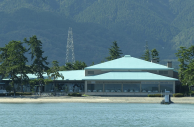
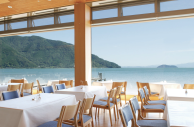

MapCode :
192 127 075*40
Phone :
074-028-1111
Website :
Address :
63-2 Nishihama, Makinocho, Takashima, Shiga 520-1812
35.0
km / 21.8
miles
-
(45
minutes)

MapCode :
101 859 607*03
Phone :
074-962-1250
Website :
Description :
国友鉄砲ミュージアム
Hours :
Open daiy 09:00 – 17:00
Address :
534 Kunitomochō, Nagahama, Shiga 526-0001, Japan
5.8
km / 3.6
miles
-
(14
minutes)

MapCode :
101 737 473*38
Phone :
074-962-8887
Website :
Hours :
Open daily 10:00 – 17:30, Closed Mondays
Address :
6-50 Sanwachō, Nagahama, Shiga 526-0055
11.9
km / 7.4
miles
-
(25
minutes)

MapCode :
101 473 215*41
Website :
Hours :
Open daily 24/7
Address :
Banba, Maibara, Shiga 521-0025
12.5
km / 7.7
miles
-
(25
minutes)

MapCode :
101 407 229*10
Hours :
Open daily 24/7
Address :
Furusawacho, Hikone, Shiga 522-0007
2.4
km / 1.5
miles
-
(8
minutes)

MapCode :
101 375 284*14
Phone :
074-927-7588
Description :
Includes Genkyuen Garden. Genkyuen Garden (玄宮園, Genkyūen) is a Japanese landscape garden with a central pond and a circular walking trail. It was built on the grounds of Hikone Castle in 1677 by the local lord for the entertainment of his guests and his family. It is designed after a palace garden from Tang China.
There are four small islands scattered across the pond, connected by bridges. Hikone Castle's main keep stands on the hill behind the garden, serving as "borrowed scenery". A cluster of wooden buildings stand next to the pond. In the past they served the entertainment of the lord's guests. Today, they can be used by contemporary tourists to enjoy a cup of tea (500 yen).
Next to the garden stands the Rakurakuen Palace, which served as the residence of the lord's family. The large wooden complex is currently being renovated. Renovation works are scheduled to continue until 2025, but they barely have any impact on a visit to Genkyuen Garden.
Yume Kyobashi Castle Road (夢京橋キャッスルロード, Yume Kyōbashi Castle Road) is a road just outside Hikone Castle's outer moat, which has been recently redesigned in a style combining the look and atmosphere of a former castle town with a pleasant, modern shopping street.
To achieve the castle town look, the buildings along the road have been designed like town houses from the Edo Period with white walls, blackened roofs and lattice doors. Various boutiques, restaurants, cafes and souvenir shops line the street, which makes for a pleasant stroll after a visit to the castle.
There are four small islands scattered across the pond, connected by bridges. Hikone Castle's main keep stands on the hill behind the garden, serving as "borrowed scenery". A cluster of wooden buildings stand next to the pond. In the past they served the entertainment of the lord's guests. Today, they can be used by contemporary tourists to enjoy a cup of tea (500 yen).
Next to the garden stands the Rakurakuen Palace, which served as the residence of the lord's family. The large wooden complex is currently being renovated. Renovation works are scheduled to continue until 2025, but they barely have any impact on a visit to Genkyuen Garden.
Yume Kyobashi Castle Road (夢京橋キャッスルロード, Yume Kyōbashi Castle Road) is a road just outside Hikone Castle's outer moat, which has been recently redesigned in a style combining the look and atmosphere of a former castle town with a pleasant, modern shopping street.
To achieve the castle town look, the buildings along the road have been designed like town houses from the Edo Period with white walls, blackened roofs and lattice doors. Various boutiques, restaurants, cafes and souvenir shops line the street, which makes for a pleasant stroll after a visit to the castle.
Hours :
Open daily 24/7
Address :
2-chōme-1-45 Honmachi, Hikone, Shiga 522-0064
23.6
km / 14.6
miles
-
(32
minutes)

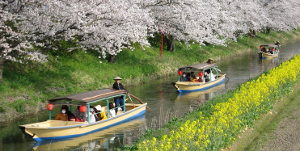
MapCode :
67 851 732*85
Phone :
074-832-2333
Website :
Description :
Richly Japanese scenery nurtured around a Lake Biwa inner lake. The people in the vicinity live hand-in-hand with water, including the fishing and reed growing industries, and the maintenance and restoration of the scenery are ongoing concerns. A scenic designated Important Cultural Property, it is also a wetlands area protected by the Ramsar Convention.
Courtesy of Biwako Visitors Bureau
Courtesy of Biwako Visitors Bureau
Hours :
Monday: 8:30 AM – 5:00 PM
Tuesday: 8:30 AM – 5:00 PM
Wednesday: 8:30 AM – 5:00 PM
Thursday: 8:30 AM – 5:00 PM
Friday: 8:30 AM – 5:00 PM
Saturday: 8:30 AM – 5:00 PM
Sunday: 8:30 AM – 5:00 PM
Tuesday: 8:30 AM – 5:00 PM
Wednesday: 8:30 AM – 5:00 PM
Thursday: 8:30 AM – 5:00 PM
Friday: 8:30 AM – 5:00 PM
Saturday: 8:30 AM – 5:00 PM
Sunday: 8:30 AM – 5:00 PM
Address :
1467-3 Maruyamachō, Omihachiman, Shiga 523-0805
3.0
km / 1.8
miles
-
(6
minutes)

MapCode :
67 791 483*50
Phone :
074-832-3151
Website :
Description :
Himure Hachimangu Shrine is an atmospheric shrine standing among tall trees at the foot of Mount Hachiman, a few steps from the lower ropeway station. With its long history, the shrine enjoyed such a high status that the town of Omi Hachiman was even named after it.
Hours :
Open daily 08:00 – 17:00
Address :
257 Miyauchichō, Omihachiman, Shiga 523-0828
0.3
km / 0.2
miles
-
(1
minutes)

MapCode :
67 791 461*76
Phone :
074-833-8567
Description :
This museum is dedicated to Japanese roof tiles with a focus on their history and significance. There is also an exhibition of different roof tiles from all over Japan. The museum consists of multiple buildings that stand on the former site of a roof tile factory.
Hours :
Open daily 09:00 – 17:00; closed Mondays
Address :
738-2 Tagachō, Omihachiman, Shiga 523-0821
0.0
km / 0.0
miles
-
(0
minutes)

MapCode :
67 791 399*17
Phone :
074-833-5020
Website :
Description :
Hachiman-bori Canal Boat Cruises
Hours: 10:00 to 16:00
Admission: 1000 yen (engine-powered), 1100 yen (man-powered)
The man-powered boats do not operate on Wednesdays, Obon, New Year and weekdays in January and February.
Two companies offer boat cruises along the canal. One uses man-powered boats that glide through the historical district at a slow pace, while the other uses engine-powered boats that explore not only the historical section, but also a more modern-looking part of the canal. Cruises last 35 minutes, and shoes must be removed on the boats.
Hours: 10:00 to 16:00
Admission: 1000 yen (engine-powered), 1100 yen (man-powered)
The man-powered boats do not operate on Wednesdays, Obon, New Year and weekdays in January and February.
Two companies offer boat cruises along the canal. One uses man-powered boats that glide through the historical district at a slow pace, while the other uses engine-powered boats that explore not only the historical section, but also a more modern-looking part of the canal. Cruises last 35 minutes, and shoes must be removed on the boats.
Hours :
Open daily 10:00 – 16:00
Address :
743 Tagachō, Omihachiman, Shiga 523-0821
0.7
km / 0.5
miles
-
(3
minutes)

MapCode :
67 791 351*28
Phone :
074-832-2456
Website :
Description :
William Merrel Vories was an American missionary, teacher and architect who came to Japan in 1905. While living in Omi Hachiman, he designed various buildings known for their Western-style aesthetic. A number of these buildings, including the old post office (shown on the picture) and his former residence, are open to the public.
Hours :
Open daily 10:00 – 16:00; closed Mondays
Address :
Moto-11 Jionjichō, Omihachiman, Shiga 523-0841
0.4
km / 0.3
miles
-
(1
minutes)

MapCode :
67 791 307*72
Phone :
074-832-7003
Website :
Hours :
Open daily 09:00 – 17:00
Address :
9-1 Moto, Ishincho, Omihachiman, Shiga 523-0864
0.3
km / 0.2
miles
-
(1
minutes)

MapCode :
67 791 180*73
Phone :
074-832-4077
Hours :
Open daily 09:00 – 16:30; Closed Mondays
Address :
2 Chome−19, Shinmachi, Omihachiman, Shiga 523-0871
0.7
km / 0.4
miles
-
(3
minutes)

MapCode :
67 790 816*32
Phone :
074-832-3323
Description :
Zuiryu-ji Temple is a Buddhist temple which stands at the top of Hachimanyama, Omihachiman City, Shiga Prefecture. It is a nunnery. Its religious school is the Nichiren sect. The founder was Nisshu (secular name, "Tomo"), a sister of Hideyoshi TOYOTOMI.
Murakumo-Zuiryu-ji Temple
History
Tomo gave her eldest son, Hidetsugu TOYOTOMI to her younger brother Hideyoshi who had no children as an adopted son. Yet, in 1596, Hidetsugu was ordered Seppuku (suicide by disembowelment), his wife and children also were executed at Sanjo-ohashi Bridge, and Yoshifusa MIYOSHI, the husband of Tomo was condemned to exile. Tomo, who had been left alone, became a nun to pray to Buddha for the happiness of the dead children and grandchildren. She established a temple of the Nichiren sect which she had long believed at a place called Murakumo (in the vicinity of Nison-in Temple at present), Saga, Kyoto City. Then, the temple land in Murakumo, the jigo (the name of a Buddhist temple) of "Zuiryu-ji Temple" and 1000 koku of temple estate was given by the Emperor Goyosei. For this reason Zuiryu-ji Temple became the only monzeki temple (a temple of high rank where members of imperial family and nobility enter the priesthood) among temples of the Nichiren sect, and was designated as "Murakumo-gosho". After that, it accepted Princess and daughters of Court nobles successively as chief abbots of a Buddhist temple. In the Edo period, it moved from Saga to Nishijin (at present, in the vicinity of Horikawa-dori Street and Imadegawa-dori Street).
After the Showa period began, Zuiryu-ji Temple declined and moved to the site of Hachimanyama-jo Castle, Honmaru (the keep of a castle) in connection with Hidetsugu TOYOTOMI in 1961 at the time of Kujo Nichijoni, the 11th of monzeki (temple formerly led by founder of sect, temple in which resided a member of nobility or imperial family), but she died before the new temple has completed. Then in 1968, it was Nichieini, the 12th of monzeki from the Ogasawara clan, who entered a monastery. Nichiei, who was compelled to become a nun due to domestic misfortunes, gave her following life for the reestablishment of Zuiryu-ji Temple.
Nichioni (Eihoni), who had been a member of Takarazuka Revue as a stage name of Hisako SAKURA, succeeded her. Nichioni became the 13th monzeki and had devoted herself to reestablish the Zuiryu-ji Temple until March 20, 2002 when she died at the age of 89.
At present, the monzeki is the 14th, Washizu Nichoni.
Kuyo (A memorial service for the dead)
On July 15 every year, for the anniversary of Hidetsugu TOYOTOMI's death, his kuyo is carried out by chief priest of Zuiryu-ji Temple at Hachiman-yama Mountain. Incidentally, Hidetsugu's Kubi-zuka (burial mound for heads) and Nisshu's graveyard are in Zensho-ji Temple (Kyoto City). There is graveyard for the 39 of Hidetsugu's wives and young children and 10 of his vassals who offered their lives, as well as Hidetsugu's Gorin Tower (a memorial gravestone for the dead) in Zensho-ji Temple (Kyoto City). Furthermore, in Koya-san Mountain where Hidetsugu committed Seppuku, there is Hidetsugu's graveyard.
Jikan (The temple)
There remains Hondo (main hall) which was reconstructed when moved from Kyoto. A view of Omihachiman City and Lake Biwa from there is said to be superb.
Murakumo-Zuiryu-ji Temple
History
Tomo gave her eldest son, Hidetsugu TOYOTOMI to her younger brother Hideyoshi who had no children as an adopted son. Yet, in 1596, Hidetsugu was ordered Seppuku (suicide by disembowelment), his wife and children also were executed at Sanjo-ohashi Bridge, and Yoshifusa MIYOSHI, the husband of Tomo was condemned to exile. Tomo, who had been left alone, became a nun to pray to Buddha for the happiness of the dead children and grandchildren. She established a temple of the Nichiren sect which she had long believed at a place called Murakumo (in the vicinity of Nison-in Temple at present), Saga, Kyoto City. Then, the temple land in Murakumo, the jigo (the name of a Buddhist temple) of "Zuiryu-ji Temple" and 1000 koku of temple estate was given by the Emperor Goyosei. For this reason Zuiryu-ji Temple became the only monzeki temple (a temple of high rank where members of imperial family and nobility enter the priesthood) among temples of the Nichiren sect, and was designated as "Murakumo-gosho". After that, it accepted Princess and daughters of Court nobles successively as chief abbots of a Buddhist temple. In the Edo period, it moved from Saga to Nishijin (at present, in the vicinity of Horikawa-dori Street and Imadegawa-dori Street).
After the Showa period began, Zuiryu-ji Temple declined and moved to the site of Hachimanyama-jo Castle, Honmaru (the keep of a castle) in connection with Hidetsugu TOYOTOMI in 1961 at the time of Kujo Nichijoni, the 11th of monzeki (temple formerly led by founder of sect, temple in which resided a member of nobility or imperial family), but she died before the new temple has completed. Then in 1968, it was Nichieini, the 12th of monzeki from the Ogasawara clan, who entered a monastery. Nichiei, who was compelled to become a nun due to domestic misfortunes, gave her following life for the reestablishment of Zuiryu-ji Temple.
Nichioni (Eihoni), who had been a member of Takarazuka Revue as a stage name of Hisako SAKURA, succeeded her. Nichioni became the 13th monzeki and had devoted herself to reestablish the Zuiryu-ji Temple until March 20, 2002 when she died at the age of 89.
At present, the monzeki is the 14th, Washizu Nichoni.
Kuyo (A memorial service for the dead)
On July 15 every year, for the anniversary of Hidetsugu TOYOTOMI's death, his kuyo is carried out by chief priest of Zuiryu-ji Temple at Hachiman-yama Mountain. Incidentally, Hidetsugu's Kubi-zuka (burial mound for heads) and Nisshu's graveyard are in Zensho-ji Temple (Kyoto City). There is graveyard for the 39 of Hidetsugu's wives and young children and 10 of his vassals who offered their lives, as well as Hidetsugu's Gorin Tower (a memorial gravestone for the dead) in Zensho-ji Temple (Kyoto City). Furthermore, in Koya-san Mountain where Hidetsugu committed Seppuku, there is Hidetsugu's graveyard.
Jikan (The temple)
There remains Hondo (main hall) which was reconstructed when moved from Kyoto. A view of Omihachiman City and Lake Biwa from there is said to be superb.
Hours :
Open daily 09:00 – 16:30
Address :
19-9 Miyauchichō, Omihachiman, Shiga 523-0828
15.6
km / 9.7
miles
-
(21
minutes)

MapCode :
616 129 569*24
Phone :
077-585-6100
Address :
2876 Imahama-chō, Moriyama, Shiga 524-0101